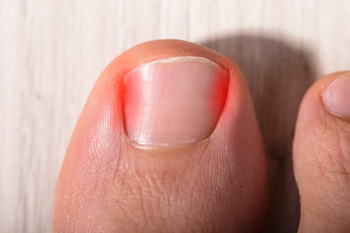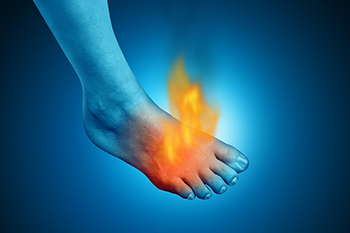Items filtered by date: March 2025
How to Manage an Ingrown Toenail

Ingrown toenails occur when the edges of the nail grow into the surrounding skin, causing pain, redness, and swelling. The area may become tender, and in some cases, it can become infected, leading to pus or an increased risk of complications. The primary causes of ingrown toenails include improper nail trimming, wearing tight shoes, or having naturally curved nails. This condition often results in sharp, throbbing pain, especially when pressure is applied, such as while walking or wearing shoes. A podiatrist can help by gently lifting the ingrown nail or, in more severe cases, removing part of the nail. This type of doctor may also recommend methods to prevent recurrence, such as proper nail care and footwear adjustments. If you are experiencing painful ingrown toenails, it is suggested that you schedule an appointment with a podiatrist.
Ingrown toenails may initially present themselves as a minor discomfort, but they may progress into an infection in the skin without proper treatment. For more information about ingrown toenails, contact Jack A. Sasiene, DPM of Texas. Our doctor can provide the care you need to keep you pain-free and on your feet.
Ingrown Toenails
Ingrown toenails are caused when the corner or side of a toenail grows into the soft flesh surrounding it. They often result in redness, swelling, pain, and in some cases, infection. This condition typically affects the big toe and may recur if it is not treated properly.
Causes
- Improper toenail trimming
- Genetics
- Improper shoe fitting
- Injury from pedicures or nail picking
- Abnormal gait
- Poor hygiene
You are more likely to develop an ingrown toenail if you are obese, have diabetes, arthritis, or have any fungal infection in your nails. Additionally, people who have foot or toe deformities are at a higher risk of developing an ingrown toenail.
Symptoms
Some symptoms of ingrown toenails are redness, swelling, and pain. In rare cases, there may be a yellowish drainage coming from the nail.
Treatment
Ignoring an ingrown toenail can have serious complications. Infections of the nail border can progress to a deeper soft-tissue infection, which can then turn into a bone infection. You should always speak with your podiatrist if you suspect you have an ingrown toenail, especially if you have diabetes or poor circulation.
If you have any questions, please feel free to contact our offices located in Texas City and Lake Jackson, TX . We offer the newest diagnostic and treatment technologies for all your foot care needs.
How Gait Disorders in Seniors Impact Their Feet

Gait disorders in the elderly significantly affect the feet, leading to discomfort, instability, and a higher risk of falls. These conditions often result from musculoskeletal issues, neurological disorders, or chronic diseases, such as arthritis and diabetes. Weakness in the foot muscles, joint stiffness, and loss of sensation contribute to unsteady movement, increasing the likelihood of injuries. Pain and deformities like bunions or hammertoes further disrupt balance, making walking difficult. Reduced mobility leads to a loss of freedom and independence, affecting mental well-being and overall quality of life. Fear of falling may cause seniors to limit their activities, resulting in muscle weakness and further instability. If you are elderly or caring for an elderly individual and notice a change in the feet or walking patterns, it is suggested that you consult a podiatrist who can offer corrective treatment and proper foot health guidance.
Proper foot care is something many older adults forget to consider. If you have any concerns about your feet and ankles, contact Jack A. Sasiene, DPM from Texas. Our doctor can provide the care you need to keep you pain-free and on your feet.
The Elderly and Their Feet
As we age we start to notice many changes in our body, but the elder population may not notice them right away. Medical conditions may prevent the elderly to take notice of their foot health right away. Poor vision is a lead contributor to not taking action for the elderly.
Common Conditions
- Neuropathy – can reduce feeling in the feet and can hide many life-threatening medical conditions.
- Reduced flexibility – prevents the ability of proper toenail trimming, and foot cleaning. If left untreated, it may lead to further medical issues.
- Foot sores – amongst the older population can be serious before they are discovered. Some of the problematic conditions they may face are:
- Gouging toenails affecting nearby toe
- Shoes that don’t fit properly
- Pressure sores
- Loss of circulation in legs & feet
- Edema & swelling of feet and ankles
Susceptible Infections
Diabetes and poor circulation can cause general loss of sensitivity over the years, turning a simple cut into a serious issue.
If you have any questions please feel free to contact our offices located in Texas City and Lake Jackson, TX . We offer the newest diagnostic and treatment technologies for all your foot and ankle needs.
Understanding Venous Ulcers and Their Impact on Lower Limbs

Venous ulcers are slow-healing wounds caused by poor circulation in the veins, typically in the lower legs and ankles. They develop when blood pools due to faulty valves, leading to increased pressure and skin breakdown. These ulcers often appear as shallow, irregular sores with discoloration, swelling, and discomfort. Individuals at higher risk include those with varicose veins, deep vein thrombosis, DVT, obesity, or a history of leg injuries. People who stand or sit for prolonged periods may also develop these chronic wounds. Venous ulcers directly affect the feet and ankles by causing swelling, skin changes, and persistent wounds prone to infection. Without proper care, complications may arise. Compression therapy, wound management, and lifestyle changes help improve healing. If you have venous ulcers, it is strongly suggested that you include a podiatrist on your healthcare team for effective treatment and prevention.
Wound care is an important part in dealing with diabetes. If you have diabetes and a foot wound or would like more information about wound care for diabetics, consult with Jack A. Sasiene, DPM from Texas. Our doctor will assess your condition and provide you with quality foot and ankle treatment.
What Is Wound Care?
Wound care is the practice of taking proper care of a wound. This can range from the smallest to the largest of wounds. While everyone can benefit from proper wound care, it is much more important for diabetics. Diabetics often suffer from poor blood circulation which causes wounds to heal much slower than they would in a non-diabetic.
What Is the Importance of Wound Care?
While it may not seem apparent with small ulcers on the foot, for diabetics, any size ulcer can become infected. Diabetics often also suffer from neuropathy, or nerve loss. This means they might not even feel when they have an ulcer on their foot. If the wound becomes severely infected, amputation may be necessary. Therefore, it is of the upmost importance to properly care for any and all foot wounds.
How to Care for Wounds
The best way to care for foot wounds is to prevent them. For diabetics, this means daily inspections of the feet for any signs of abnormalities or ulcers. It is also recommended to see a podiatrist several times a year for a foot inspection. If you do have an ulcer, run the wound under water to clear dirt from the wound; then apply antibiotic ointment to the wound and cover with a bandage. Bandages should be changed daily and keeping pressure off the wound is smart. It is advised to see a podiatrist, who can keep an eye on it.
If you have any questions, please feel free to contact our offices located in Texas City and Lake Jackson, TX . We offer the newest diagnostic and treatment technologies for all your foot care needs.
Common Reasons for Burning Foot Pain

Burning feet can result from various conditions that affect the nerves, blood flow, or soft tissues of the foot and ankle. Peripheral neuropathy is a common cause of burning feet. It is often linked to diabetes or nerve compression, and can lead to sensations of burning, tingling, or numbness. Morton’s neuroma, a thickening of tissue around a nerve in the ball of the foot, can also cause a burning sensation, particularly when walking. Tarsal tunnel syndrome, which involves compression of the tibial nerve near the ankle, may result in burning pain along the inner foot and toes. Other possible causes of burning foot pain include peripheral vascular disease, which restricts blood flow and may lead to burning pain during movement, and metatarsalgia, where excessive pressure on the forefoot leads to irritation and discomfort. Some inherited nerve disorders, such as Charcot-Marie-Tooth disease, can also contribute to persistent burning sensations in the feet. A podiatrist can diagnose the cause of burning feet and offer treatment options, including orthotics, medication, or surgery, if needed. If you frequently experience the sensation of burning feet, it is suggested that you schedule an appointment with a podiatrist for an exam, diagnosis and appropriate treatment.
Foot Pain
Foot pain can be extremely painful and debilitating. If you have a foot pain, consult with Jack A. Sasiene, DPM from Texas. Our doctor will assess your condition and provide you with quality foot and ankle treatment.
Causes
Foot pain is a very broad condition that could be caused by one or more ailments. The most common include:
- Bunions
- Hammertoes
- Plantar Fasciitis
- Bone Spurs
- Corns
- Tarsal Tunnel Syndrome
- Ingrown Toenails
- Arthritis (such as Gout, Rheumatoid, and Osteoarthritis)
- Flat Feet
- Injury (from stress fractures, broken toe, foot, ankle, Achilles tendon ruptures, and sprains)
- And more
Diagnosis
To figure out the cause of foot pain, podiatrists utilize several different methods. This can range from simple visual inspections and sensation tests to X-rays and MRI scans. Prior medical history, family medical history, and any recent physical traumatic events will all be taken into consideration for a proper diagnosis.
Treatment
Treatment depends upon the cause of the foot pain. Whether it is resting, staying off the foot, or having surgery; podiatrists have a number of treatment options available for foot pain.
If you have any questions, please feel free to contact our offices located in Texas City and Lake Jackson, TX . We offer the newest diagnostic and treatment technologies for all your foot care needs.

